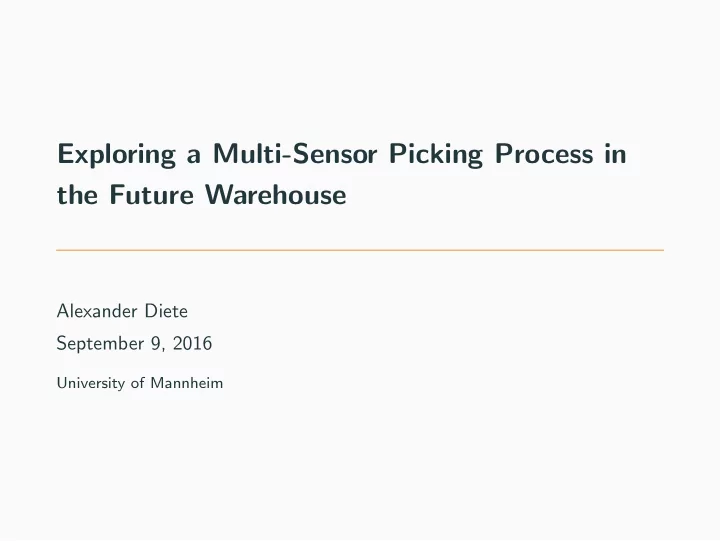

Exploring a Multi-Sensor Picking Process in the Future Warehouse Alexander Diete September 9, 2016 University of Mannheim
About the project
Problem Figure 1: Picking process in warehouses 1
Idea Use sensors and video data to enhance the process 2
Hardware • Data glass (Vuzix M100) • Wristband (Custom 3D Print) • Depth Sensor (Project Tango Tablet) 3
Data gathering
Data collected • Data glass • IMU data • Video stream • Wristband • IMU data • RFID read • Tango • Point cloud data 4
Recording Session Figure 2: Different parts being recorded 5
Point cloud Figure 3: 3rd person depth view 6
Recording Application Figure 4: Sensor Data Collector App 7
Activities to be recognized • Navigation (walking to shelf) • Locating shelf • Grabbing into shelf 8
Problems • Time synchronization • Consistent recording rate for the sensors • Start and endpoint of labels 9
Solutions • Zero lining for time synchronization • Align datasets in post-processing • Manual sensor rate adjustment for glasses • Use observation video to pinpoint start and end of activities 10
Solutions - Alignment tool 11
Solutions - Labeling tool 12
Dataset
Description • First recording session resulted in 2.7 GB • Different processes recorded • Picking from one shelf • Picking from multiple shelves • Picking with different hands 13
Example Figure 5: Accelerometer data from wristband 14
Future Work
Recording optimization • Switch to full client server architecture • Synchronized start of all devices recording • Health status of sensors • Reduce the overall setup time • Better live preview of data • Video stream and plot of data • Includes health status of sensors 15
Machine Learning • Video stream • Object recognition (boxes, shelves) • Motion detection • Sensor data • Activity recognition (walking, standing, arm movement) • Combination of both data streams 16
Depth information • 3rd person perspective vs. 1st person perspective • 3rd person perspective feasible for recognition but hard to deploy. • 1st person perspective: minimum distance of depth sensor is 30cm • Means that detection of objects is not feasible • But: Can recognize if background is blocked by some object • Thus grabbing detection should be possible 17
Conclussion
Summary • Created a framework for collecting multiple data sources • Built tools to align and label data • Proposed multiple approaches for activity recognition 18
Open Questions • Is the selection of sensors sufficient for task? • Can machine learning be applied to the combination of data? • Semi supervised learning applicable for different warehouse locations? 19
Thank you for your attention
Recommend
More recommend